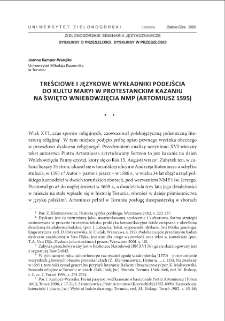Digital Library of Zielona Góra contains 9 272 digital objects
Object
Title: Treściowe i językowe wykładniki podejścia do kultu Maryi w protestanckim kazaniu na święto Wniebowzięcia NMP (Artomiusz 1595) = Content-based and language-based indicators of the approach to the worship of Our Lady in the Protestant sermon given on the Day of the Assumption of Mary (Artomius 1595)
Contributor:
Hawrysz, Magdalena - red. nauk. ; Jurewicz, Magdalena - red. nauk. ; Kotlarska, Irmina - red. nauk.
Group publication title:
Abstract_pl:
Przedmiotem artykułu jest treściowa i językowa analiza XVI-wiecznego tekstu pt. "Sermon to jest kazanie na dzień Wniebowzięcia Panny czystej (?)" autorstwa toruńskiego kaznodziei Piotra Artomiusza. Celem szkicu jest przyjrzenie się językowym wykładnikom subiektywnego wartościowania wypowiedzi, ich analiza oraz omówienie ewentualnych strategii wykorzystanych przez autora w celu przekazania określonych treści i obrony prawd wiary. ; Jako tło porównawcze omawianych zagadnień wykorzystano katolickie kazanie Piotra Skargi napisane na ten sam dzień kalendarza liturgicznego - 15 sierpnia - święto Wniebowzięcia NMP (1595). Analiza treściowa tekstów dowiodła, że polemiczne kazanie Artomiusza wpisuje się w ówczesny dyskurs religijny i reprezentuje raczej umiarkowany odłam luteranizmu. ; Zdolności kaznodziejskie toruńskiego pastora ujawniają się nie tylko na płaszczyźnie treściowej, ale również językowej. W celu przekazania określonych treści i przekonania do nich odbiorcy wykorzystuje on bowiem różne środki perswazji i językowe wykładniki stylu retorycznego, z których niektóre zostały w artykule wskazane i omówione (np. porównania, przeciwstawienia, słownictwo wartościujące, pytania retoryczne).
Abstract:
The article addresses the content-based and language-based analysis of the 16th century text titled "Sermon to jest kazanie na dzień Wniebowzięcia Panny czystej (?)" written by Peter Artomius, the priest of Toruń. The aim of the outline is to look at the language-based indicators of the subjective judgement of utterances, to analyse them and to describe possible strategies applied by the author in order to transmit certain content and to defend the principles of faith. ; The comparative background for the issues addressed in the article is the Catholic sermon of Piotr Skarga, which was written on the same liturgical day - 15 August - the Day of the Assumption of Mary (1595). The analysis of the content proved that the polemic sermon written by Artomius constituted part of the religious discourse of the time and represented the moderate faction of Lutheranism. ; The Toruń`s priest`s talent of preaching of is revealed not only in the content but also in the language of the sermon. In order to transmit certain content and convince the recipient, he various means of persuasion and linguistic exponents of the rhetoric style, some of which have been referred to in the text (e.g. comparisons, contrasts, evaluative language, rhetorical questions).
Publisher:
Zielona Góra: Oficyna Wydawnicza Uniwersytetu Zielonogórskiego
Format:
Resource Identifier:
Pages:
Source:
Zielonogórskie Seminaria Językoznawcze 2019
Language:
Rights:
Biblioteka Uniwersytetu Zielonogórskiego
Object collections:
- Repository > Faculties > Faculty of Humanities
- Repository > Types of work > Articles
- Repository > Scientific journals and UZ publishing series > Zielonogórskie Seminaria Językoznawcze
Last modified:
Jan 31, 2024
In our library since:
Jan 31, 2024
Number of object content hits:
154
All available object's versions:
https://zbc.uz.zgora.pl/repozytorium/publication/86928
Show description in RDF format:
Show description in OAI-PMH format:
Objects Similar
Jurewicz-Nowak, Magdalena Hawrysz, Magdalena - red. nauk. Jurewicz, Magdalena - red. nauk. Kotlarska, Irmina - red. nauk.
Hawrysz, Magdalena Hawrysz, Magdalena - red. nauk. Uździcka, Marzanna - red. nauk.
Kępińska, Alina Hawrysz, Magdalena - red. nauk. Uździcka, Marzanna - red. nauk.
Ślęczka, Tomasz Sztyber, Radosław - red. nacz.
Jurewicz-Nowak, Magdalena Hawrysz, Magdalena - red. nauk. Uździcka, Marzanna - red. nauk.
Kulwicka-Kamińska, Joanna Hawrysz, Magdalena - red. nauk. Jurewicz, Magdalena - red. nauk. Kotlarska, Irmina - red. nauk.
Sawa, Anna Hawrysz, Magdalena - red. nauk. Uździcka, Marzanna - red. nauk. Wojciechowska, Anna - red. nauk.
Hawrysz, Magdalena - red. nauk. Jurewicz, Magdalena - red. nauk. Kotlarska, Irmina - red. nauk.

